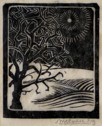- Printmaking technique- started in late 1800s in Germany to make wallpaper.
- Originally, designs were cut into wood (“woodcuts” or “block prints”).
- Eventually, linoleum was used because it didn’t split and didn’t have a grain, and was easier to cut than wood.
- Linoleum printing became popular in the early 1900s as an inexpensive way to teach printmaking to children.
- Famous artists who did linoleum printing include Pablo Picasso, Henri Matisse and M.C. Escher.
- Multi-colored prints can be made by using a different block for each color, but Picasso was able to create prints using the ‘reductive’ print method. This means he cut away what he didn’t want imprinted with the subsequent color.
- Linoleum printing works well for line lesson or for positive/negative space.
- Speedball cutting tools- handles and blades are in two separate bins
- Speedball block printing ink
- Brayers and trays
- Large wooden or metal spoons to rub paper if you don’t have extra brayers
- Inking trays
- Paint brushes for hand painting colors if desired
- Sturdy paper (not watercolor paper- needs to be smooth but stiff enough to hold up to thick paint. Drawing paper works, or purchase multi-media paper at Michael’s.)
- Scrap paper to plan design, pencil to draw with
- Newspaper or butcher paper to protect table and more paper to create a drying area
- Set up printing stations with two spaces, one for inking and one for printing- you’ll need ink, brayer, ink trays, paper, paper towels, extra paper to replace messy butcher paper in printing station
- No dueling with cutting tools.
- Demonstrate how to change blades- Loosen metal ring on the end of the tool and insert rounded part of blade into the slot next to the metal ball, inside the thin metal C-shaped piece. DO NOT COMPLETELY LOOSEN THE METAL RING or the pieces will fall apart and may become lost. It’s not necessary to loosen ring all the way- just enough to be able to insert blade end.
- MAKE SURE YOU COUNT ALL BLADES AND HANDLES BEFORE YOU ALLOW STUDENTS TO USE!!! VERY IMPORTANT!!!!! Also do an inventory before leaving the room at the end of your lesson. The blade bins are labeled with the blade number and the count. Depending on your class, you can have a parent supervise the distribution of blades, or you can allow students to choose as needed. I strongly suggest allowing only one or two blades per kid at a time.
- When students are cutting, make sure they cut AWAY from their bodies, not towards their hands. They will want to hold the linoleum down as they cut, but they have to keep their hands behind the direction they’re cutting or they may slip and cut their thumbs. STOP any student you see cutting in this manner and redirect. VERY IMPORTANT that you monitor this to prevent serious injury. TOOLS ARE VERY SHARP!
- No using the blades on anything except the linoleum.
- Each blade has a specific use- the thin blade is for cutting narrow lines; the wider V-shaped blades cut lines that are wider; the rounded C-shaped and U-shaped blades cuts away larger sections, etc.
- Explain history of linoleum printing and introduce artists/artwork.
- TALK ABOUT SAFETY RULES! (as described above)
- Students should plan a design on scrap paper that is simple, very much like a coloring book drawing. Keep in mind that the print will be the reverse of what they cut, so words/numbers must be drawn/cut BACKWARDS in order to be forwards once printed. (Discourage words/numbers if possible to avoid mistakes.)
- Once students are happy with their designs, they can use pencil on the back on their design to transfer their work, or they can draw freehand on the linoleum with a pencil, though it doesn’t erase if they make a mistake. It won’t matter unless they forget about it and make the cut unintentionally. Suggest that they redraw their design with a pen or marker if they can’t see their pencil lines.
- Students need to consider what they will cut away and what they will keep. Whatever is cut away will be WHITE; whatever is kept will be the color of the ink. They should plan this on their design. Ask them as they work their designs what they’ll be cutting away. They may want to make an outline or cut entire sections away, but they’ll still need to plan for an outline of a cut-away section. Talk about positive and negative space. THINK CAREFULLY BEFORE CUTTING.
- Cutting should be done carefully and slowly. Students should make their first few cuts tentatively until they get a feel for how much to cut, or how deeply they should cut. It’s important not to cut too much away, because it can’t be put back. If they cut away too much, they will have to change their design to accommodate their ‘mistake.’ They can always cut away more after their first print. Once they are satisfied with their linoleum block, they can begin printing.
- Make sure block is clean and free of dust, linoleum particles, etc.
- Students will use brayer to apply ink to block, making sure the ink layer is evenly distributed over entire block.
- Move block to a clean print area (immediately next to inking station). Apply the paper to the block (not the block to the paper), and smooth a large spoon or a clean brayer over the paper to make sure the ink is evenly applied.
- Carefully and slowly pull the paper from the block from the top corner to the bottom and examine the print. If the student likes the print as is, they can clean the block in the sink with water and print again. They should make several prints in different colors and on different papers. Encourage them to make extra prints and share with their classmates.
- If the student wants to make changes to their design, they should clean the linoleum block and cut away anything they want to eliminate. Repeat printing process.
- Prints should be allowed to dry flat in a drying area nearby but away from traffic.
- If a student wants to do multiple colors on a single print, have them try hand painting the colors onto their block before they print.
- Make sure the ink is well mixed before squeezing onto tray. Shake and squish tube to mix, then use the brayer to further mix and smooth the paint. A few drops of water can be added if the ink is too thick or not consistent. Run the brayer several times in different directions to mix.



